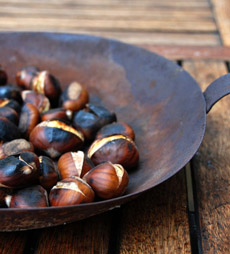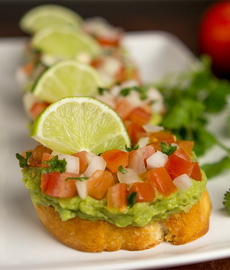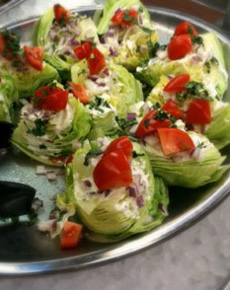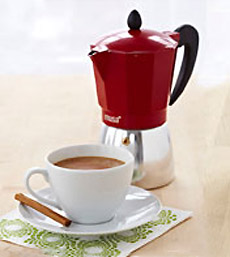
[2] Chestnuts roasted in a specialty chestnut pan (photo © Histomil).

[3] Chinese five-spice powder. The recipe is below (photo Marietta Spice Mill).
|
|
RECIPE #1: TIPSY CHESTNUT CAKE
Ideally, prepare the cake a day in advance to allow the wine syrup to thoroughly meld with the crumb.
Since you need less than 1-1/4 cups of wine, you can use up leftover wine—or serve the rest of a new bottle with the cake.
Ingredients For 8-10 Servings
2 cups all-purpose flour
3/4 cup granulated sugar
1 teaspoon Chinese five-spice powder (recipe below)
1 teaspoon baking powder
3/4 teaspoon baking soda
1/2 teaspoon salt
2 cups (10 ounces) very coarsely chopped roasted chestnuts (fresh or canned)
3/4 cup dry red wine (Such as Cabernet Sauvignon,
Merlot or Pinot Noir)
1/2 cup unsweetened applesauce
1 teaspoon vanilla extract
For The Crimson Wine Syrup
1/4 cup dark brown sugar, firmly packed
1/3 cup dry red wine
Pinch salt
|
Preparation
1. PREHEAT oven to 325°F with rack in the center. Lightly grease and flour an 8 x 4-inch loaf pan.
2. WHISK together the flour, sugar, five-spice powder, baking powder, soda, and salt in a large bowl until thoroughly combined. Add the chopped chestnuts and toss to coat with the flour blend to prevent the pieces from sinking to the bottom of the cake. Set aside.
3. MIX the wine, applesauce, and vanilla in a separate bowl; then add to the wet goods into the flour mix. Use a wide spatula to combine, stirring just enough to blend without over-mixing. It’s perfectly fine to have a few lumps remaining.
4. TRANSFER the batter to the prepared loaf pan and smooth out the top before sliding the pan into the oven. Bake for 55-60 minutes, until deeply browned on top and a toothpick inserted into the center comes out clean. While the cake is baking…
5. PREPARE the red wine syrup by combining the wine, brown sugar, and salt in a small saucepan over medium heat. If you’d like the wine to retain a bit of its alcoholic bite, cook just until the sugar has dissolved. Alternatively, allow it to simmer for 5-10 minutes for the alcohol to boil out.
6. PREPARE the baked cake while it is still warm by poking it numerous times with a skewer. Go deep to allow the syrup to penetrate far into the crumb. Pour the hot syrup over the cake and let cool completely before removing it from the pan. Although the cake tastes best the next day after soaking a bit, it’s quite delicious to slice and serve as soon as it’s cool.
RECIPE #2: CHINESE FIVE-SPICE POWDER
What is Chinese five-spice powder?
Like adobo, chili powder, curry powder, fines herbes, garam masala, herbes de provence, ras-el-hanout, togarishi, za’atar, and other global spice blends, the ingredients and the proportion of ingredients vary based on the cook or the manufacturer. Some five-spice recipes include anise seed, black or white pepper, cardamom, galangal, ginger, licorice, mandarin peel, nutmeg, and turmeric.
Since the five-spice powder is also used in other Asian cuisines and in Middle Eastern cooking, there are regional preferences as well.
Blend together:
1 teaspoon ground cinnamon
1 teaspoon ground cloves
1 teaspoon fennel seed, toasted and ground
1 teaspoon ground star anise
1 teaspoon Szechuan peppercorns, toasted and ground
Store any extra spice in an airtight jar.
CHECK OUT WHAT’S HAPPENING ON OUR HOME PAGE, THENIBBLE.COM.
|









